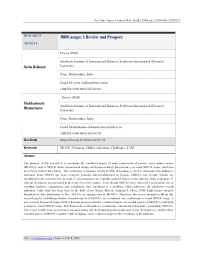MOOC usage: A Review and Prospect
Автор: Savita K., Shubhasheesh B.
Журнал: Science, Education and Innovations in the Context of Modern Problems @imcra
Статья в выпуске: 5 vol.8, 2025 года.
Бесплатный доступ
The purpose of this research is to investigate the combined impact of main components of massive open online courses (MOOCs), such as MOOC kinds, instructional design, and learner-related characteristics, on actual MOOC usage, which has never been looked into before. The technology acceptance model (TAM) of learning is used to determine this influence. Literature from 2008-19 has been reviewed. Journals indexed/abstracted in Scopus, EBSCO, and Google Scholar are shortlisted for the current review. In total, 75 research papers are critically analyzed. Based on the objective of the evaluation, 37 relevant documents are presented in the form of a review matrix. Even though MOOCs have witnessed a tremendous rise in enrolling numbers, engagement, and completion after enrolment is a problem, which influences the platform's overall utilization. Little study has been done in the field of use (Fianu, Blewett, Ampong & Ofori, 2018). High learner dropout (Saadatdoost, Sim, Jafarkarimi, & Hee, 2015) is an ongoing issue in MOOCs. Therefore, this review attempts to fill up this research gap by establishing whether essential aspects of MOOCs, in a combined way, could improve actual MOOC usage. A new research framework using TAM of learning proposes that the combined impact of essential aspects of MOOCs would help to improve actual MOOC usage. This framework would guide to revolutionize educational technologies, particularly MOOCs. The review would create an awareness among learning and development professionals and course developers to consider these essential aspects of MOOCs together while designing course content to improve the overall use of the platform.
MOOC, Pedagogy, Higher education, Challenges, TAM
Короткий адрес: https://sciup.org/16010703
IDR: 16010703 | DOI: 10.56334/sei/8.5.5310.56334/sei/8.5.54
Текст научной статьи MOOC usage: A Review and Prospect
/ Savita K., Shubhasheesh B. (2025). MOOC usage: A Review and Prospect. Science, Education and Innovations in / the Context ofModern Problems, 8(5), 543-555; doi:10.56352/sei/8.5.53.
Researchers have conducted various types of studies related to the development of the MOOC platforms, their instructional approach, learner skills, and characteristics, etc. However, little effort has been made to improve the actual use of MOOC platform courses. This paper attempts to study the combined impact of essential aspects of MOOC on actual usage. It has proposed a new research framework for the same with the help of TAM of learning [3].
The current review reviews studies related to MOOC design features, types, learner-related aspects such as (skills, characteristics, challenges, context) and actual usage.
In the literature, MOOC comes in various types, for example, tiny open online courses (TOOCs), miniature private online courses (SPOCs), xMOOCs, and cMOOCs (Yousef, Chatti, Schroeder, Wosnitza, & Jakobs, 2014). TOOCs have supported collaboration and interactivity (Bernhard & Bittel, 2016) and SPOCs have improved traditional classroom learning (Bansal & Singh, 2015) [4]. The instructional design quality studies have found poor-quality course design impacting course scores (Margaryan, Bianco, & Littlejohn, 2015). Another study has focused on the association between MOOC features such as videos, discussion forums, and learner use of MOOCs (Wang & Baker, 2015). Credit transferability (Kolowich, 2013; Kop, 2011), high dropout rate, pedagogy (Saadatdoost et al.; 2015), digital literacy issues, course structure, certification, and evaluation (Chatterjee & Nath, 2014) are some of the MOOC challenges requiring attention In addition;


